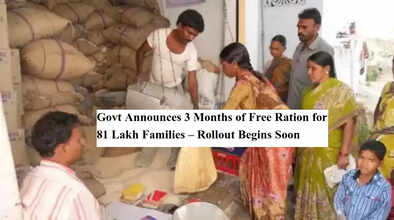Govt Announces 3 Months of Free Ration for 81 Lakh Families – Rollout Begins Soon

In a major relief to economically weaker families across India, the Central Government has launched a new initiative to distribute free ration to 81 lakh families for the next three months. This welfare step aims to support vulnerable communities struggling with daily food expenses amidst rising costs and limited income opportunities.
The move is part of the government’s broader commitment to social welfare and food security, especially for families living below the poverty line (BPL) and those with special circumstances like old age, disability, or children.
Who is Eligible for the Free Ration?
To benefit from this scheme, families must meet specific eligibility criteria set by the government. The primary beneficiaries will be low-income households who fall under the state-specific income thresholds.
Here are the key eligibility requirements:
-
BPL families or low-income group households
-
Priority given to homes with:
-
Senior citizens
-
Children
-
Persons with disabilities
-
-
Applicants must present valid documentation, including:
-
Ration Card
-
Proof of Residence
-
Income Certificate
-
Government-issued ID (e.g., Aadhaar Card)
-
Families meeting the criteria are urged to gather all necessary documents to avoid any delays during verification and distribution.
When Will the Distribution Start?
The distribution of free ration is expected to begin from next month, as per government sources. The rollout will be phase-wise, beginning in urban areas and gradually expanding to rural and remote regions to ensure comprehensive coverage.
The phased approach allows for proper coordination and real-time adjustments, helping authorities handle demand efficiently across different regions.
How the Scheme Will Be Implemented
The government has laid out a detailed implementation strategy involving both the central and state governments, supported by local administration.
Here’s how the rollout will be managed:
-
Phase-wise distribution starting with densely populated areas
-
Collaboration with state governments for seamless coordination
-
Use of technology to track distribution, minimize fraud, and ensure transparency
-
Focus on last-mile delivery, particularly in rural belts and tribal regions
-
Monitoring by local authorities, including periodic audits
Support Systems and Feedback Mechanisms
To ensure the program’s effectiveness and address any concerns:
-
Dedicated grievance redressal centers will be set up
-
NGOs and civil society organizations will assist in identifying and supporting beneficiaries
-
Feedback systems will be enabled via helplines and mobile apps
-
Government channels will provide real-time updates on ration availability and location-wise delivery
The program will also undergo regular reviews to measure its impact and improve its delivery efficiency.
A Step Towards Food Security and Social Justice
The government’s decision to offer free ration for three months to over 81 lakh families comes at a time when many households are dealing with inflation and limited employment opportunities. This initiative aims to safeguard the nutritional needs of the poor, especially in underserved communities.
By prioritizing the digitization of services, local coordination, and transparent distribution systems, the government hopes to prevent leakages and ensure that the benefits reach the right hands.
Conclusion:
This major step is not just about free food distribution—it's a commitment to the dignity and well-being of every Indian citizen, especially the most vulnerable. Eligible families are encouraged to check their documents and stay connected to official updates for the latest information.

